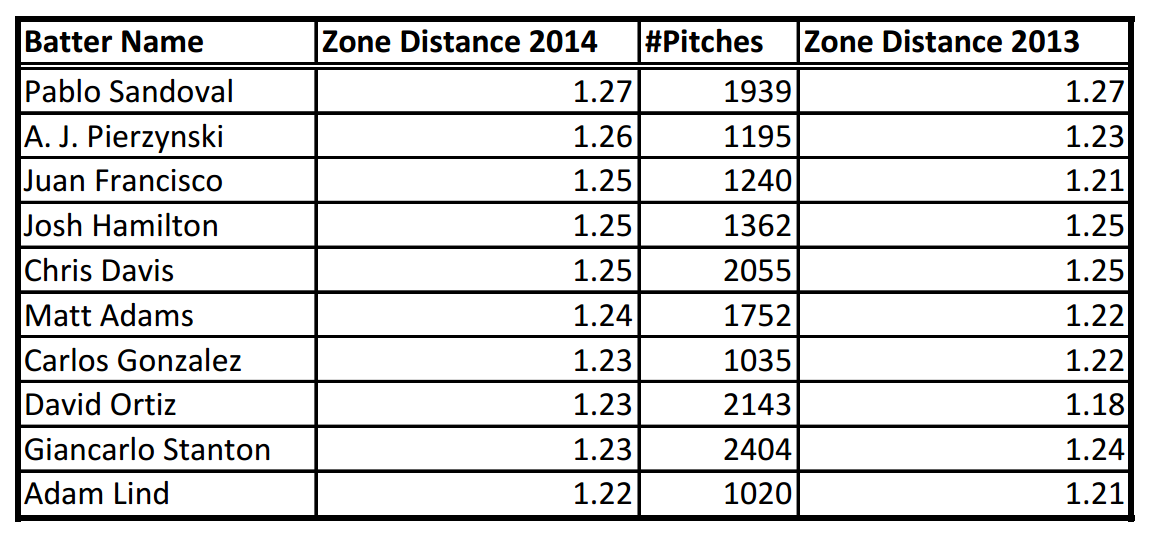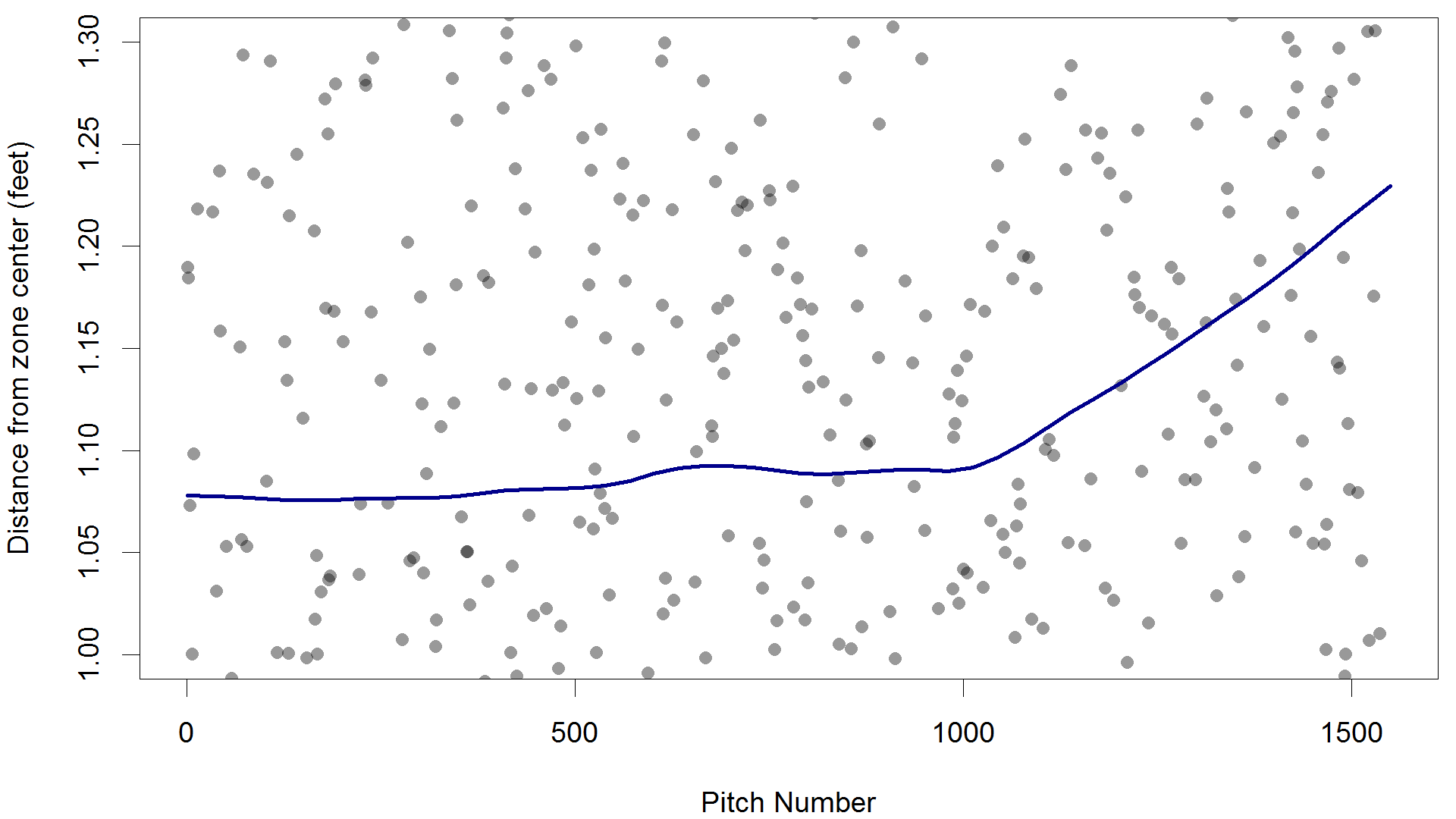For a pitcher, the center of the strike zone presents a high-risk, high-reward proposition. There is the opportunity to steal a strike against an overly patient hitter, but also the possibility of the ball being walloped for extra bases. From a game theory prospective, pitchers must balance the need to acquire additional strikes versus the added risk which comes from throwing those strikes.
Yet, the inherent risk of a strike varies depending on who is standing in the batter’s box. Jose Bautista can hit a pitch middle-middle a long way, maybe out of the park. Ben Revere is less of a threat to achieve the same outcome. For this reason, pitchers can be more aggressive in pitching to the center of the zone against Ben Revere than Jose Bautista.
It is from this basic logic that we arrive at the idea of zone distance. In brief, each hitter gets thrown his pitches at a certain distance from the center of the zone, which usually ranges from about 12 to 15 inches. As it turns out, this metric correlates very well with the slugging ability of the hitter, and changes in zone distance can be used to predict changes in a hitter’s slugging ability.
We’re now most of the way through another year of MLB play, long enough for zone distance to stabilize and then some. Hitters have changed. Pitchers have changed the ways in which they approach hitters to compensate. Let’s check up on the zone distance records of hitters so far this year.
The first thing to note is this: if a hitter had a high zone distance in 2013, he will probably have a high zone distance in 2014.

The year-to-year correlation is about R2=.68, suggesting strong concordance across years in terms of zone distance.
Zone distance generally balances the fear the pitcher has of the batter with the batter’s predilection to swing. If the hitter will swing at balls far away from the zone, the pitcher doesn’t need to get close to the center in order to get strikes. As a result, the consistent, nearly unmatched player upon the zone distance leaderboards as far back as I have looked has been none other than the Kung-Fu Panda himself, Pablo Sandoval.

Sandoval is that rare combination of a hitter with no eye for the zone whatsoever who still, somehow, against all odds, manages to muster up a good offensive profile. He’s therefore perfect for the top of the zone distance leaderboards.
The other guys at the top shouldn’t be too surprising either. Pierzynski isn’t very good, but he’ll swing at anything, and as he’s aged, his ability to discriminate between strikes and balls has completely decayed. Josh Hamilton is a bit Panda-like in his predilection for outside swings, but then underneath him is the troubled Chris Davis. Davis has fallen upon hard times this year, following his miraculous (and zone distance predicted) breakout in 2013. The zone distance leaderboards suggest that he’s not any different in the eyes of the pitchers, even though his batting average has fallen into sub-Mendoza territory. And yet, reinforcing the zone distance finding, his OBP sits a good 100 points better. For all of his struggles, his zone is just as bereft of pitches as it was in his breakout.
On to the bottom of the leaderboards.

Ben Revere’s total lack of power is well-documented, but there are some surprises on this list. I wrote about Travis d’Arnaud earlier this year, and I am still somewhat pessimistic on account of indicators like this. Since the time of that article, d’Arnaud’s zone distance has trended considerably upward, and yet he is still second to last among everyday regulars. It might be that his dark days are behind him, and the league is adjusting to his new and improved skill set, or it might be that he’s on a lucky tear.
More surprising than d’Arnaud is Dustin Pedroia. Pedroia has had a fairly typical Pedroia season in 2014, albeit down slightly across the board. Still, he’s a very good regular player with an above-average TAv and typically skillful defense at second, which is an extremely valuable package. The change in his zone distance makes me concerned for his future, however. PECOTA projects him as a .283 TAv player going forward, and it will be interesting to see its prediction for next year, but I can see some possible trouble looming next year, especially given the aging trends of second basemen.
I wrote about Kurt Suzuki for a Lineup Card. At that point I had looked at his zone distance, as well as its trend, and concluded that while Suzuki deserved his All-Star bid on the basis of his play to that point, he was poised for collapse. I was half-right: Suzuki sustained one more good month, July, largely on the basis of a .358 BABIP, and then August came, and he fell to a more Suzuki-appropriate OPS of .653. He had a good run this year, of that there can be no question, but I do not (and would not) buy his improvement as genuine going into next year (which will make his contract all the more regrettable).
We can also look directly at who gained and lost the most zone distance between years. Here are the top 10 zone distance increases.

Heading the list is Robbie Grossman, which is a fact for which I have no solid explanation. Grossman is a slightly-below replacement level outfielder who has a stat-line curiously resembling Chris Davis: an incredibly low batting average, coupled to a surprisingly high OBP (more than a hundred points better). It’s clear that he’s patient, and all of his plate discipline statistics are trending in the right direction, which perhaps suggests good things for his future statistics.
One hitter I’m happy to see here is J.D. Martinez. Martinez came out of Houston to become an excellent hitter on the Tigers, and the mechanical changes he made to his swing are well documented. He appears to be the rare case of a player who made genuine adjustments to his game which significantly improved his skills mid-career, and it’s nice to see zone distance confirming that.

On the flip side, some of the prominent losers of zone distance are Yasiel Puig and Miguel Cabrera. Puig saw an exceedingly careful approach against him when he first came to the league, but responded with patience and excellent pitch recognition. I don’t think his loss of zone distance is a sign of trouble so much as a recognition on the part of pitchers that the first method they attempted to use against him just hasn’t worked.
Miguel Cabrera’s presence on this list, on the other hand, is somewhat more worrisome. I don’t think he’s doomed or going to fall off a cliff tomorrow. But it was inevitable that Cabrera’s historic offensive seasons weren’t going to continue forever. So far this year he’s been good, but not great, and I think that’s a decent expectation for him next year as well. His walk rate in particular has fallen, and zone distance sheds some light on why that might be: he’s simply not seeing those distant pitches which were easy to take for balls any more.
The Early Breakout Candidates of 2015
In a few articles earlier this year, I explained a potential method for predicting which players might exceed their PECOTA projections by the most substantial amounts. The logic of the method was that since zone distance reflected the pitcher’s opinions of a batter’s skill level, we could use the change in zone distance over the course of a year to predict the change in a batter’s skill level in the next year.
This idea could have died, as so many good hypotheses have, but instead, it works surprisingly well. Over the past three years, breakout candidates identified with my method have outperformed their PECOTA projections by some 10-20 points on average. Given that we have almost the complete 2014 season on the books (or, in the case of Pitchf/x, in the spreadsheets), we can make a few early guesses as to the breakout candidates of 2015*. To wit:

Here, higher zone distance trend indicates that the zone distance is increasing more as the year goes on. There’s some intriguing candidates here. J.D. Martinez appears again, and in the sense that PECOTA probably hasn’t picked up on his (probably) genuine improvement, it will probably underrate his TAv going into next year.
Adrian Beltre looks like a “breakout” candidate in the David Ortiz mold, who was on this same kind of list for each of the last two years. It’s not especially likely that he’s suddenly going to become a lot better, but PECOTA, following normal age-related decline patterns, will likely forecast him to get worse, and, if the method is working properly, he won’t. This happened in each of those two years with Ortiz.
In each of the past two years, in addition to the slate of moderate over-performers there was at least one completely surprising and drastic breakout (2013: Chris Davis; 2014: Victor Martinez). It’s impossible to detect who 2015’s player will be (if there will be one), but I am intrigued by Ike Davis. Davis has flashed the raw ability necessary for elite play, and many of his plate discipline statistics are trending in promising directions. If he could also succeed in terrifying opposing pitchers into feeding him plenty of outside pitches, it seems to me possible that he could put together a truly superstar-class season. The change in zone distance is certainly sudden and severe, as the following chart shows (with a LOESS line fit).

I should note that the season isn’t finished. There’s time for all of these zone distance trends to be negated in the remaining month. What’s more, I’m still using a crude, linear method to detect breakouts. While it has worked in a statistically significant manner in the past, there are improvements yet to be made. So for now, consider these breakout candidates provisional.
*To make these candidates a little more robust, I’m going to limit it to players with more than 1500 pitches, which mostly gets at everyday regulars.
Thank you for reading
This is a free article. If you enjoyed it, consider subscribing to Baseball Prospectus. Subscriptions support ongoing public baseball research and analysis in an increasingly proprietary environment.
Subscribe now
I think you are onto something here. Initially when I looked at zone distance, I found that LHP and RHP for a given batter had fairly correlated zone distances, but probably there's more to it than that for individual hitters, especially when they have large pre-existing platoon splits.
Being able to tell if a month or two's performance was likely to continue or stop is an awfully useful thing. But I have been wondering if you could use spikes in zone distance over shorter periods of time to reliably predict whether a hot streak or a cold streak is going to end soon or continue . . . the issue, of course, is the need for 250 pitches to have stable data. That's about 16 games for a patient hitter. I am guessing that most streaks last less than 16 games, so by the time you had stable data, the opportunity would have passed. Any thoughts on this one?
I had the same idea recently about hot streaks. The barrier, as you say, is the stabilization rate of distance metrics. But, it seems like it might be possible somehow.
It's possible that the Pirates are systematically getting pitched further away, but I don't see a lot of support for it in the data. It might just be that you're noticing higher distances for guys like McCutchen, Alvarez, Harrison, Marte, and Walker, but then again, those guys are all pretty good hitters, so I think higher zone distance is to be expected.